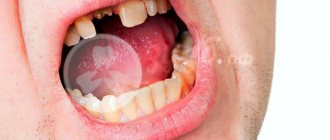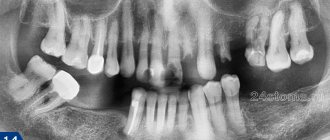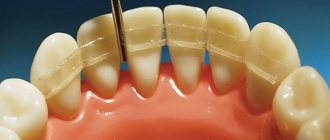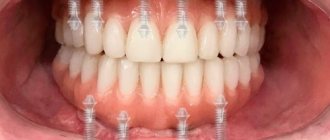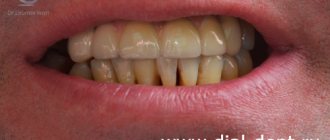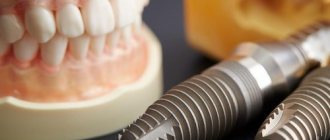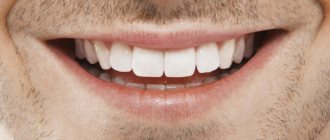A beautiful smile undoubtedly matters to a person. After all, this is what many people fix their attention on when they meet. A smile leaves an unforgettable impression on the interlocutor. It plays an important role in your confidence when communicating. A beautiful smile will improve contact with your interlocutor, improve behavior and leave behind all sorrows and self-doubt, and will also melt the heart of any stranger. But if the smile is not perfect and there is a defect in the front teeth (cracked dental plate, extracted tooth, crooked bite or tooth fragment, caries), how can we talk about self-confidence? Such a person will become isolated from others, become withdrawn, stop smiling, and will feel awkward when communicating. All this can leave a mark on a person’s profession and on his personal life.
No one wants to show problems with their front teeth to others, so dentures are the best solution for such patients.
When performing prosthetics after removal, it is important to restore and preserve the functions of the organ:
- Correct bite;
- Shape;
- Natural color;
- Gum health.
Prosthetics of the front teeth is also an aesthetic issue, therefore, to create a beautiful smile, it is necessary to use high-quality, durable materials that will visually look good. In dentistry, several methods of installing dentures are used and leading materials are used to give each patient a dazzling smile.
The main indications for the use of anterior dental prostheses are:
- Cracks in the dental plate, chips, broken teeth;
- Lost teeth or congenital adentia;
- Carious teeth;
- Crooked bite;
- Yellowing or darkening of the enamel;
- Crooked teeth, irregular shape and uneven “facial” surface of the tooth;
- Early unsuccessful prosthetics.
To solve your problem and select the correct method for installing dentures after removing your front teeth, you can consult the Dr. Levin dental clinic by calling the clinic.
What prostheses can be placed in the smile zone - the most complete list of solutions and their features
Article navigation
- Indications for prosthetics
- Important Features
- Prosthetic options
- Removable prosthetics
- Fixed dentures
- Implantation of incisors and canines
- Which dentures are better?
- Which material to choose
- In what situations is enamel grinding not necessary?
- Periodontitis and periodontal disease
- Contraindications
- Dentists' recommendations
- Price
Question for a specialist
People practically do not use incisors for chewing food, which is why when restoring them, high demands are placed mainly only on aesthetics and restoration of the correct bite. It is very important that your smile looks natural and natural. However, the material must still be strong enough to withstand the average load of biting food. Because of all these features, prosthetics of the front teeth contains many nuances, which will be discussed further.
Treatment of tooth canals under a microscope
To eliminate inflammation at the roots of the two front teeth, dental canal treatment was performed under a microscope. The significant magnification provided by the microscope helps to thoroughly clean the canals of the teeth and not miss the branches and bends of the canals. Thanks to the professionalism of the endodontist and excellent equipment, the infection in the canals, which causes inflammation at the roots, is completely eliminated.
After dental treatment under a microscope, the canals are hermetically sealed and the bone at the roots is restored. Treatment under a microscope saves teeth from removal.
Indications for prosthetics in the smile area
When thinking about prosthetics for the upper or lower front teeth, you need to know in what cases it is necessary. It is clear that the complete absence of an incisor or canine tooth along with the root is a direct indication for prosthetics. But there are other cases when it is a prosthesis in the classical sense that is needed, and not a filling. Let's look at the main indications for prosthetics in the smile area:
- chipped crown: the defect is more than half of its original size,
- cracks in the enamel or its abrasion,
- malocclusion: only in case of minor pathologies it is corrected with dentures, otherwise braces/aligners (orthodontic aligners) are needed,
- frequent caries under fillings,
- enamel defects: darkening, smoker’s plaque, “tetracycline” staining, fluorosis, thin enamel layer,
- complete absence of a tooth along with the root.
That is, prosthetics are necessary to recreate the aesthetics and functionality of a smile, as well as to create a more attractive appearance. The latter is especially true for public people and women.
Advantages of treatment at Dial-Dent
There is a great advantage in clear treatment planning and budgeting. The patient knows the cost of treatment in advance (and does not find out about the upcoming expenses in the middle of the journey, when it is no longer possible to suspend treatment), plans his time and finances. With clear planning, costs are reduced (for example, when installing an implant, bone or soft tissue plastic surgery can be performed immediately, rather than breaking this process into two operations, using sedation twice), time is saved (several specialists can be visited in one visit to the clinic).
Proper treatment planning is helped by the fact that the clinic is equipped with modern diagnostic equipment (including a computed tomograph) and employs all the necessary specialists.
Important features of restoration of incisors and canines
Features of prosthetics of the anterior teeth of the lower and upper jaw are as follows:
- it is important to recreate the aesthetics of the smile and face: choose the right shape and color of dentures that are identical to the enamel of neighboring units of the dentition,
- it is important to pay attention to the position of the gums: the contour of the mucous membrane should be natural and natural,
- it is important to ensure good fixation of the prosthesis: so that a person can not only smile, but also bite and chew food normally (although biting off very hard foods will no longer be possible in any case),
- It is important that the restoration does not cause discomfort and does not provoke pathologies: allergies or inflammation.
South Korean implant Osstem - 20,000 rub.
Hurry up to sign up for a free consultation and lock in promotional prices.
Call now or request a call
Opening hours: 24 hours a day - seven days a week
Removable prosthetics and its features
- When to use: if one or more front teeth are missing along with the roots, that is, they are completely removed.
The peculiarity of removable dentures is that they are fixed to the supporting teeth with hooks (clasps). These clasps are noticeable when you smile (if the hooks are made of metal) or often become loose and break (if the clasps are made of plastic). The attachments can damage the enamel of the supports or the surrounding gums, causing inflammation. By the way, this can also include a rapid decline in aesthetics, because plastic teeth quickly darken from plaque, and it will not be possible to whiten them to an ideal state.
Most often, a removable butterfly prosthesis is placed on the front teeth (if the chewing ones are preserved) - and only as a temporary solution. In other cases, in order to also partially restore the chewing teeth, you will have to make a massive prosthesis with a voluminous plastic palate or gum - this way it will hold better, but with less comfort.
In orthopedic dentistry, there are the following types of removable dentures:
- acrylic: made of long-known and inexpensive acrylic plastic,
- Acry-free (“Acry-free”): a modern variation of the previous type. Made from plastic that contains virtually no acrylic monomer (somewhat a toxic substance found in conventional acrylics),
- polyurethane: Russian alternative to nylon structures. The material is soft and flexible,
- clasp: unlike all the others, clasps have a metal arch, which adds rigidity and more correctly distributes the chewing load. The upper palate is not made solid, but in the form of a small bridge, which increases wearing comfort. Clasp ones will be placed only if at least part of the lateral teeth is missing, otherwise they simply cannot be fixed,
- Quattro Ti (“Quadrotti”): similar to clasp ones in structure and scope, but “Quadrotti” do not have a metal arc. They are made only from Dental D material (a combination of nylon and plastic), patented by Quattro Ti.
To read about each individual type of prosthesis, click on the name to go to the corresponding page with a description.
Fixed dentures to restore the smile area
- When to use: if teeth have lost their aesthetics, are partially destroyed, there are chips - these are indications for installing veneers or crowns. If the teeth are missing along with the roots, then bridges are placed.
Fixed ones correspond to almost all features of prosthetics, since they are highly aesthetic, are well fixed, and the absence of plastic gums and palate makes wearing them quite comfortable. But all this provided that an experienced orthopedist was involved in the prosthetics, high-quality materials and technological equipment were used.
%akc72%
The advantage of non-removable ones is that they last much longer than removable ones. Fixed ones do not move, they do not need to be taken out of the mouth to clean (and the person will not forget to put them back), they do not need to be glued to the cream, and there is no need to get used to a foreign object in the mouth. The disadvantages include the cost, which is significantly higher than that of removable ones.
Aesthetic prosthetics – veneers, lumineers, ultraneers
Veneers, lumineers and ultraneers are durable and aesthetic microprostheses for the smile area; they are installed only on the front part of the dentition and mask minor defects, creating a “Hollywood smile”. They can cover cracks in the enamel, small chips, interdental spaces (diastemas and trema), and slightly level the inclination of the teeth.
Veneers (in fact, lumineers and ultraneers are also veneers) are presented in the form of thin ceramic overlays. Their thickness varies between 0.3-0.6 mm. And if ultraneers are just thin veneers (0.3 mm), then lumineers are already a patented brand with its own manufacturing technology (the thickness of lumineers is about 0.2 mm). You can evaluate the aesthetics of lumineers restoration using photos before and after prosthetics of the front teeth.
Among the positive aspects of veneers are the highest aesthetics and durability (10-20 years of trouble-free wear). The disadvantages include very careful operation of the restoration, high cost, and the need to install 6-8 veneers or lumineers per row at once. But in the case of classic veneers, it is possible to replace one or two front teeth.
Traditional prosthetics with crowns
If the top is destroyed by more than half, but the roots are intact, it is recommended to use dental crowns.
A crown is a cap-shaped prosthesis that restores a single defect and is placed on some kind of support. It perfectly follows the shape of the natural tooth apex and is fixed very firmly with special cement. But it is rarely possible to remove a crown without damaging it, for example, to treat root canals or periodontitis. In this case, you have to make a new one. And after several removals/fixations, a situation often arises that the root has to be removed (if it is severely damaged due to caries or frequent treatment). Then it is no longer possible to install a crown; you have to look for other prosthetic options.
To fix the crowns, a certain support is required:
- the preserved part of the natural tooth apex: it is previously ground down to give the shape of a stump or a truncated cone,
- post: a metal screw that is secured into the tooth root. The advantages of the method are low price, the disadvantages are uneven load on the root, insufficient fastening reliability,
- stump tab: a more successful (but also expensive) analogue to a pin. The inlay can be made of durable metal-free materials, the shape exactly follows the cavity inside the root and rises above the gum so that the crown can be fixed to it. Metal-free materials transmit light in a similar way to natural tooth enamel. This option looks more aesthetically pleasing and will last many times longer than pins.
Bridges
They are used when 1-4 teeth are missing in a row. A necessary condition is the presence of supports (or their healthy roots) along the edges of the defect.
Bridges (or bridges) are several crowns connected in a row. Bridges differ from single crowns in that they do not have holes at the bottom and rest on the gums, and the outer ones are created for fixation on supports. Also, “wings” – located along the edges of the bridge – can be attached to these supports.
Adhesive bridges1 have just such “wings”. These bridges are temporary, but are fixed quite reliably (they can come off due to chewing gum or very hard food). The installation can be performed on children and adults - on a temporary basis while awaiting implantation, for example.
The advantages of bridges include high aesthetics, long-term fixation and comfortable operation. But they have a very big drawback - the need to grind down the supports and remove their “dental nerves”. These factors, plus additional chewing load, lead to rapid failure of the supports. You have to re-treat them, and eventually remove them - and each time you need to redo the bridges or make new ones. As a result, when the defect becomes very extensive, you will have to completely abandon bridges in favor of other types of prosthetics.
Another significant disadvantage is that when wearing bridges (as well as removable structures), the bone will constantly atrophy under the plastic base or “empty” crowns. Along with the bone, the gums also recede, making the smile unattractive and allowing food to accumulate in the space between the denture and the gums. After every few months of wearing it, you have to go to an orthopedist and adjust the displaced prosthesis.
Prosthetic replacement of anterior tooth after extraction
After tooth extraction, it is better to do its prosthetics using the express implantation technique, in the absence of contraindications. To do this, immediately after tooth extraction, an implant and a special abutment are installed in its alveolar socket to form the correct gum shape. A crown is temporarily placed on it. After the implant has healed for approximately several months, a permanent crown is installed.
The advantages of express implantation include:
- This procedure does not require any additional incisions, which is less traumatic to the gums;
- The implant is installed in an open manner, which also does not require additional surgical intervention;
- This method is perfect for patients who do not want to wait until the hole heals and a bridge or crown can be installed.
- Short healing period;
- There are few side complications that are unpleasant for the patient.
Implantation of incisors and canines – installation of 1 crown and bridge on implants
- When to use: in the absence of any number of teeth on any of the jaws. These may be single or isolated defects; an entire segment or all teeth may be missing at once. You can even place an implant in the hole of a recently removed tooth root.
An implant is an artificial metal root that is fixed in the bone tissue if there is no tooth root in it. When restoring anterior teeth, it is recommended to install a white aesthetic abutment made of zirconium dioxide. It also corrects the position of the gums, which allows you to achieve ideal aesthetics.
Today, the most ideal method of prosthetics in dentistry is dental implantation. It is suitable for any area of the dentition, with any number of defects - from single and scattered to complete edentia. The most significant advantages of implantation look like this:
- no need to grind down adjacent teeth,
- the highest possible aesthetics – crowns on implants are completely indistinguishable from natural teeth,
- very strong fixation of the implant in the bone and the crown on the implant itself,
- ability to withstand good loads: but the frontal zone should not be overloaded,
- materials for implantation are biocompatible with the body,
- implant-supported dentures have the highest wearing comfort,
- the service life of the implant is eternal, and the prosthesis on it will last at least 15-25 years,
- implants help rebuild the bone around them, maintaining gum level.
Crowns or bridges are placed on top of the implants, as well as bridges with small inclusions of artificial gum (to mask the uneven contour of the natural gum).
Installation of dentures for anterior teeth without turning
This is the restoration of damaged teeth, when the neighboring teeth intended for support are not ground down or depulped. In this case, it is worth performing implantation. This is one of the most gentle and atraumatic methods of installing upper and lower teeth. The essence of the method is that in the place of the lost tooth, an implant is installed in the jaw bone tissue, which performs the function of a root. Subsequently, a crown is put on it.
There are also methods that do not require grinding of a layer of healthy teeth, but they are rather temporary.
To summarize: which prostheses are better?
Which prosthesis is better to choose for prosthetics of front teeth? Let's summarize all the information already available and determine the optimal solution.
| Problem | The best decision |
| If 1 tooth is missing with a root | The crown on the implant will last from 15 years, and the service life of the implant is decades |
| If several teeth are missing | A segment or several crowns, again installed on implants |
| If the top is chipped | If the chip is small - less than 30% of your own enamel, then a veneer is placed. If most of it is missing, a crown on a pin or stump tab |
| If the top is destroyed | If the roots are healthy and intact, then a crown is placed on the stump tab. If the roots are destroyed, they are removed and an implant is placed. |
Life after implantation
Once the implants have settled in and the crowns have been placed, it is important to properly care for them in order to maintain the results for as long as possible. The rules for caring for teeth with implant roots are standard, but with some peculiarities.
Firstly, you should use a brush with medium-hard bristles to avoid traumatizing the mucous membranes and ensure high-quality cleansing of new teeth. An implantologist or orthopedist will advise which paste is best to choose.
Secondly, it is advisable to rinse your mouth after every meal, but alcohol-based rinses are not suitable for this due to their ability to dry out the mucous membranes. A person with installed implants should have dental floss and an irrigator in their arsenal.
On a note! Insufficiently careful care of teeth on implants can shorten their service life and even lead to rejection.
What material to choose for dentures in the smile area
- plastic and metal-plastic: the most affordable option, but has poor aesthetics and a short service life, therefore it is used only as a temporary solution,
- metal ceramics: a durable and inexpensive option, but not aesthetically pleasing enough for the smile area. In addition, if the metal comes into contact with the gum, it will turn blue over time - this will be noticeable,
- solid ceramics: looks as natural as possible and is quite durable, especially provided that in the frontal area the load on the teeth is minimal,
- Zirconium dioxide or aluminum oxide: the most preferred option, natural, strong and durable. But also the most expensive.
When is metal ceramics used?
Metal-ceramic crowns are one of the most popular options in orthopedic dentistry. It is used quite often because it has an affordable price, high strength and aesthetics. However, they are best used to restore the masticatory sections, but not the anterior ones.
The disadvantages of metal ceramics are as follows:
- may cause allergies: in this case, the cobalt-chromium alloy can be replaced with gold, but the cost of treatment will increase significantly,
- when metal and gums come into contact, “cyanosis” of the mucous membrane may occur,
- your own tooth enamel must be sharpened,
- Mandatory nerve removal is required, even if the root canals are healthy.
When to use ceramics
A more preferable option for the frontal zone. Moreover, modern ceramics have become stronger and more durable. Such dentures are distinguished by natural translucency, the ability to select the shade of ceramics in full accordance with the color of natural enamel. They do not cause blue gums and require minimal grinding of the own enamel, while the dental nerve (if indicated) can be preserved. The only drawback is that they are higher in price than metal-ceramic ones. In addition, it is not advisable to fix them on implants or pins - a metal base can lead to splitting of the structure. Solid ceramics are attached only to your own tooth or core inlay.
When is zirconium dioxide used?
Zirconium dioxide or aluminum oxide are durable materials that are processed using modern computerized equipment. CAD/CAM technology is used to create a customized prosthesis, as well as scanning the entire oral cavity and modeling structures in a computer program. This allows you to achieve incredible precision at all stages of prosthetics. Among the main advantages are the longest service life (from 15-20 years), incredible aesthetics of both the restoration itself and the gum area, the absence of allergic reactions and minimal grinding of the enamel.
Not only crowns and bridges, but also veneers can be made from ceramics and zirconium dioxide.
Don't know what type of prosthetics to choose?
We will help in the selection, advise where to read more information and compare types of prosthetics.
Consultation with an orthopedic doctor in Moscow clinics is free! Call now or request a call
Working hours: from 9:00 to 21:00 - seven days a week
Metal crowns –
Modern metal crowns in dentistry are made using the one-piece casting method and are called “solid-cast”. There are also stamped and gold crowns, which at this stage of development of dentistry can only be interesting from a historical point of view.
- Solid crowns (Fig. 11-12) - such crowns are most often made from a cobalt-chromium alloy, and therefore their surface looks like a well-polished metal. However, it is also possible to apply gold plating. Advantages: high strength and wear resistance, long service life, low price. The disadvantage is the lack of aesthetics. The price of 1 such crown for 2022 will be from 5,000 rubles.
Such metal crowns behave well on chewing teeth (outside the smile line), and in addition, their production requires less grinding of hard dental tissues - compared to metal-ceramics. The latter allows you to extend the service life of the crowns. Also, crowns of this type can be lined with plastic facets on the front side, which will somewhat improve their aesthetics. Read about all the pros and cons of such structures at the link below.
→ Cost and features of cast crowns
- Stamped crowns - stamping is an outdated method of manufacturing metal crowns, which, however, can still be found in remote corners of Russia and the CIS.
Such crowns are stamped from special blanks (steel sleeves of different sizes). It is possible to spray the crown “like gold”. The only advantages of such crowns were minimal tooth processing and low cost. Disadvantages of stamped crowns – → complete lack of aesthetics, → the thin wall of the crowns often leads to “eating” of the crown, → low precision of work - the crown does not fit well around the neck of the tooth, which causes saliva, microorganisms, and food debris to leak under the crown. This leads to decay of the tooth under the crown.
- Gold crowns (Fig. 13) –
Today, gold crowns are made mainly only in state dental clinics, because
Working with precious metals requires a license, and obtaining one is very difficult. In addition, their cost will be comparable to the cost of crowns made of metal-free ceramics, which deprives their use of any economic sense. Gold crowns: the price of gold dental crowns will consist of the cost of gold (+ 5,000 rubles per gram) + the cost of work. You need to keep in mind that it is impossible to immediately say a specific price per tooth. The required mass of gold will depend on the size of the tooth, and the larger it is, the more gold it requires (from 2 to 5 g), and the more expensive it will be.
In what situations is enamel grinding not necessary?
How is prosthetics performed in the frontal area? First, the oral cavity is prepared - caries is treated, tartar and plaque are removed, and if necessary, diseased roots are removed. Then, if you need to place a crown, bridge or veneers, you first need to grind down the supports. After this, impressions are taken (you can also perform a 3D scan of the oral cavity), which are sent to the laboratory. But turning can be avoided if the following restoration options are chosen - lumineers, clasp on hooks, immediate or removable dentures.
Periodontitis and periodontal disease - is it possible to get dentures with such a diagnosis?
If you have periodontitis and periodontal disease, there are not many options for restoring your smile. For example, it could be a splinting “clasp” that will fix loose teeth, but will not cure periodontitis or periodontal disease. Therefore, these pathologies will have to be treated regularly, although they never go away 100%, especially in the later stages.
The ideal option again is implantation, because... implants are not natural roots on which plaque would accumulate, leading to the progression of periodontitis. Implants even promote the regeneration of your own bone and, accordingly, increase the level of gums. But here it is important to understand that it is often impossible to do without removing the remaining diseased teeth or their roots, because they are the source of infection.
Prevention of periodontitis
To prevent periodontitis, the patient is recommended to undergo professional teeth cleaning twice a year. If plaque forms on your teeth quickly, or you have problems with self-hygiene, then it is better to visit a hygienist more often, this will preserve the health of both your teeth and gums. Read more about prevention and hygiene measures here.
The patient took a break for some time to prepare financially for further treatment. Doctors did everything to maintain the health of the dental system while waiting.
Contraindications for prosthetics
All existing contraindications relate for the most part to fixed prosthetics. Moreover, there are many relative contraindications – those that can be “bypassed” over time. For example, relative prohibitions on the installation of fixed bridges or crowns, as well as implants, are imposed on the following groups of patients:
- children under 18 years of age, pregnant women: this is due to the characteristics of bone tissue and the ban on certain anesthetics,
- for diseases of the oral cavity: caries, pulpitis, stomatitis - first you need to be cured,
- for periodontitis and periodontal disease: with classic removable and fixed prosthetics, as well as with two-stage implantation. BUT! When implanted using one-stage protocols - for example, with basal implantation or all-on-6, these pathologies are not considered a contraindication.
There is, perhaps, only one absolute contraindication for removable orthopedic structures, which, by the way, also applies to non-removable ones - these are very serious mental disorders. Also, absolute contraindications, but for implantation, include the following:
- decompensated diabetes mellitus,
- serious pathologies of the heart and blood vessels, endocrine system,
- malignant diseases in the acute stage,
- tuberculosis, HIV,
- inability to carry out high-quality oral hygiene.
Instrumental studies – tomography and x-ray
They are performed on all patients, regardless of the chosen implantation technology. Based on the data obtained, the issue of the types of implants and the methodology of the implantation operation itself will be decided.
An X-ray is taken selectively, precisely in the part of the jaw where implants are planned to be installed. Using it, the doctor evaluates the condition and location of the roots of the teeth, near which the implant should be installed. The price of such a photo starts from 700 rubles.
A panoramic photograph is needed for any type of prosthetics, and implantation is no exception. Otherwise, it is called an orthopantogram and is performed to take into account the characteristics of the bite and the condition of the bone tissue. All this is of great importance, since a strong foundation is extremely important for the implant root.
The price of a 3D image - orthopantogram - from 1500 rubles.
But the most important study at the diagnostic stage is CT - computed tomography. Without it, not a single dental implantation operation is performed, and neither an X-ray nor an orthopantogram can replace it.
Computed tomography is the most expensive examination at the diagnostic stage, the price of which starts from 3,000 rubles. Based on its results, the quality of bone tissue is assessed, the sites for installing implants and their type are selected. It is the tomogram that allows the implantologist to conclude that bone grafting is necessary if there is insufficient bone volume.
Modern medical centers where implantation operations are performed are equipped with high-precision equipment and use navigation programs. All this makes it possible to plan the course of treatment in detail and even show its future results to the patient!
Recommendations from dentists when choosing a prosthesis
When restoring small defects, chips and darkening, it is better to choose thin ceramic veneers or lumineers - they will make your smile beautiful for 15 years or more.
Removable orthopedic solutions in the smile area often lose their fixation, move, provoke allergies and cause difficulty chewing medium-hard food. Therefore, it is recommended to install them only as a temporary option: while the patient waits for the installation of a permanent fixed prosthesis or implant. Here, a defect in a row or a ground stump is masked with a plaster or bridge so that the smile retains its attractive appearance. Biting food with these restorations is not recommended. On an ongoing basis only if there are contraindications to fixed solutions or implantation, as well as financial limitations.
Fixed options for restoring minor dental defects, such as crowns and bridges, are quite popular due to their availability. If the natural crown is destroyed by more than half, then a worthy option is a ceramic or zirconium dioxide crown coated with ceramics. But in the case of a bridge, the patient is not immune from bone atrophy and gum loss under the prosthesis, as well as from overloading the supports.
Therefore, the optimal method for restoring the frontal zone will be implantation, because implants prevent the bone from further atrophying and maintain the aesthetics of your smile for several decades.
By the way, positive reviews from 90% of patients who underwent implantation speak of the highest comfort of life even 10-15 years after prosthetics. While 60% of people who have had classic removable prosthetics or bridges subsequently regret their decision.
The cost of restoring the smile area
How much does front tooth replacement cost? It all depends on the type of prosthesis, its design, complexity of manufacturing and installation, as well as on the materials and rating of the clinic. For example, restoration of a single defect with a composite veneer costs from 7,000 rubles, with a ceramic veneer – from 15 thousand, and one lumineer costs from 50 thousand.
Prices for metal-ceramic crowns start from 6,500 rubles, for ceramic ones – from 18 thousand, and zirconium dioxide – from 25 thousand. The cost of the bridge is calculated according to the number of crowns. A butterfly prosthesis costs from 12 thousand, a plate prosthesis can be ordered for 15-20 thousand, and clasp prostheses, Acri-free and Quadrotti cost from 35-40 thousand rubles. Installation of 1 implant on a turnkey basis, i.e. together with the crown, it will cost at least 35-40 thousand rubles - this is the most budget option, and premium brands cost 2-3 times more.
- Ervandyan A. G. Clinical and laboratory justification for the use of adhesive bridges made of ormokers and fiber materials: Dis. Ph.D. honey. Sci. Moscow, 2005. - 140 p.
Combined crowns/bridges –
An example of one of the combinations of materials in the manufacture of crowns is metal-plastic (Fig. 14-15). They, like cast crowns, are made using a solid casting method from a cobalt-chrome alloy, but the front surface is subsequently additionally lined with white plastic. The price for metal-plastic crowns will be from 7,000 rubles per unit, and their advantages include acceptable aesthetics.
Disadvantages of metal-plastic crowns –
- Plastic in the oral cavity quickly loses its aesthetic properties, and over time, the white color of the plastic changes to gray. In addition, plastic tends to absorb liquid and swell slightly. This causes the plastic to begin to smell like unbrushed teeth over time.
- Metal-plastic crowns are also not very reliable: if the teeth are clenched tightly or while chewing, the plastic lining may simply fall out.
- Plastic is not very good for health (especially for allergy sufferers), because... there is always some amount of chemically active monomer remaining in it. The latter can be released for a very long time.
Combined bridges –
The metal frame of metal-ceramics and cast metal crowns are made according to the same principle - using the one-piece casting method. Therefore, different types of crowns can be combined in one bridge. For example, you need to make a bridge of 3 units (supported by teeth 5-7). In this case, the first 1-2 crowns falling into the smile line are made of metal-ceramic, and the distant crowns are made of solid casting (Fig. 16).
Dentists and dental technicians are not very fond of such designs, because... this reduces their cost. And if they tell you that this cannot be done, then this will only speak of the doctor’s personal reluctance. Moreover, such designs have other advantages (besides the price). For example, teeth for cast crowns require much less grinding than for metal-ceramic crowns, and therefore this design can last longer.
